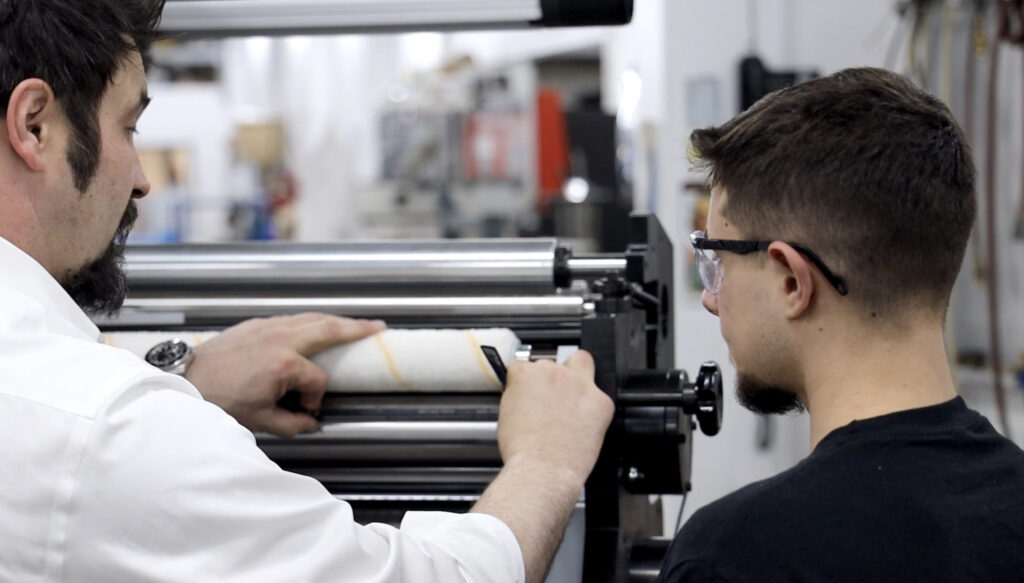In the world of print production, finishing is a critical stage that can greatly influence the final quality and appearance of printed materials. The choice between inline and offline finishing can have significant implications for efficiency, cost, and flexibility in the production process. This blog will explore the differences between inline and offline print finishing, highlighting the advantages and potential drawbacks of each approach to help you determine which might be best suited for your business needs.
What is Print Finishing?
Print finishing refers to the processes that take place after a document has been printed, such as cutting, folding, binding, laminating, and inserting special features like RFID tags or window patches. These finishing touches are essential for creating professional, high-quality printed products, from brochures and booklets to packaging and labels.
Inline Finishing: Seamless Integration in the Production Line
What is Inline Finishing?
Inline finishing refers to the integration of finishing processes directly into the printing line. This means that as soon as a document is printed, it moves immediately into finishing stages such as cutting, folding, or binding without any manual intervention or delays. Inline finishing equipment is typically connected to the printing press, allowing for a continuous, uninterrupted production flow.
Advantages of Inline Finishing:
- Efficiency and Speed: Because finishing is integrated directly into the printing process, inline finishing can significantly reduce production time. There’s no need to move printed materials between different machines or locations, which streamlines operations and minimizes handling errors.
- Consistency and Quality: Inline finishing systems are highly automated, which helps ensure consistency across large print runs. The integrated nature of the process also reduces the risk of damage or errors that can occur when materials are manually transferred between different stages.
- Space-Saving: Since inline systems combine printing and finishing in one continuous operation, they can save valuable floor space in production facilities. This is particularly beneficial for businesses with limited space.
- Investment Cost: Inline is often less of an investment than offline due to the repurposing of press equipment such as unwind/die cut/rewind.
Potential Drawbacks of Inline Finishing:
- Flexibility: While inline systems are efficient, they may lack the flexibility to handle a wide variety of finishing tasks. If a job requires complex or specialized finishing that the inline system can’t accommodate, it may not be the best option.
- Potential Delays: Any downtime in the printing line can halt the entire process, leading to potential production delays.
Offline Finishing: Flexibility and Customization
What is Offline Finishing?
Offline finishing involves performing finishing processes separately from the printing line. Once printing is complete, the printed materials are transferred to dedicated finishing equipment, where they undergo various processes such as cutting, folding, binding, and more. This separation allows for greater flexibility in how and when finishing is done.
Advantages of Offline Finishing:
- Flexibility: Offline finishing offers the flexibility to handle a wide range of finishing tasks, from simple cuts and folds to complex, multi-step processes. This makes it ideal for jobs that require specialized finishing or customizations that inline systems may not support.
- Scalability: Because finishing is separate from printing, different jobs can be processed simultaneously on multiple finishing machines, which can increase overall production capacity. This also allows businesses to handle varying job sizes more efficiently.
- Equipment Utilization: Offline finishing equipment can be used independently of the printing press, which means it can be utilized continuously, even if the printing line is down or busy with another job.
Potential Drawbacks of Offline Finishing:
- Time-Consuming: Offline finishing requires additional steps to transfer printed materials from the printing press to the finishing equipment. This can introduce delays and increase the potential for handling errors.
- Space Requirements: Unlike inline systems, offline finishing requires separate equipment and space, which can be a challenge for businesses with limited production areas.
- Consistency: Manual handling between printing and finishing stages can introduce variability and increase the risk of damage, especially in large print runs.
Choosing the Right Approach for Your Business
When deciding between inline and offline finishing, it’s important to consider the specific needs of your business, including the types of print jobs you handle, your production volume, and your available resources.
- Inline finishing is ideal for high-volume, standardized jobs where speed and consistency are critical. It’s a great choice for businesses looking to streamline operations and reduce production time.
- Offline finishing offers the flexibility and scalability needed for complex or varied finishing tasks. It’s best suited for businesses that require a high level of customization or need to handle a diverse range of print jobs.
Tamarack® Offers Advanced Finishing Solutions
Tamarack® offers state-of-the-art equipment designed to meet the demands of both inline and offline finishing processes. Our Vista Window Patching Equipment integrates seamlessly with inline systems, providing precise and efficient application of window patches in packaging.
For RFID applications, we offer the MVW Inline RFID Insertion Equipment for high-speed integration directly in the production line, as well as the MVW Offline RFID Inlay Insertion Equipment for flexible, stand-alone finishing processes. These advanced solutions are designed to enhance your production capabilities, whether you prioritize efficiency, flexibility, or a combination of both.
With over 50 years of experience, Tamarack Products continues to provide innovative integrated labeling and finishing technology. Our commitment to quality, innovation, and customer satisfaction sets us apart in the industry. Contact us today to learn how our expertise and advanced solutions can transform your business operations.





